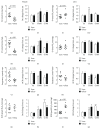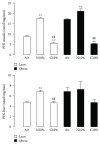Nocturnal Hypoxia Improves Glucose Disposal, Decreases Mitochondrial Efficiency, and Increases Reactive Oxygen Species in the Muscle and Liver of C57BL/6J Mice Independent of Weight Change
- PMID: 29507654
- PMCID: PMC5817288
- DOI: 10.1155/2018/9649608
Nocturnal Hypoxia Improves Glucose Disposal, Decreases Mitochondrial Efficiency, and Increases Reactive Oxygen Species in the Muscle and Liver of C57BL/6J Mice Independent of Weight Change
Abstract
Although acute exposure to hypoxia can disrupt metabolism, longer-term exposure may normalize glucose homeostasis or even improve glucose disposal in the presence of obesity. We examined the effects of two-week exposure to room air (Air), continuous 10% oxygen (C10%), and 12 hr nocturnal periods of 10% oxygen (N10%) on glucose disposal, insulin responsiveness, and mitochondrial function in lean and obese C57BL/6J mice. Both C10% and N10% improved glucose disposal relative to Air in lean and obese mice without evidence of an increase in insulin responsiveness; however, only the metabolic improvements with N10% exposure occurred in the absence of confounding effects of weight loss. In lean mice, N10% exposure caused a decreased respiratory control ratio (RCR) and increased reactive oxygen species (ROS) production in the mitochondria of the muscle and liver compared to Air-exposed mice. In the absence of hypoxia, obese mice exhibited a decreased RCR in the muscle and increased ROS production in the liver compared to lean mice; however, any additional effects of hypoxia in the presence of obesity were minimal. Our data suggest that the development of mitochondrial inefficiency may contribute to metabolic adaptions to hypoxia, independent of weight, and metabolic adaptations to adiposity, independent of hypoxia.
Figures







Similar articles
-
Effects of different acute hypoxic regimens on tissue oxygen profiles and metabolic outcomes.J Appl Physiol (1985). 2011 Sep;111(3):881-90. doi: 10.1152/japplphysiol.00492.2011. Epub 2011 Jul 7. J Appl Physiol (1985). 2011. PMID: 21737828 Free PMC article.
-
Opposing effects of reduced kidney mass on liver and skeletal muscle insulin sensitivity in obese mice.Diabetes. 2015 Apr;64(4):1131-41. doi: 10.2337/db14-0779. Epub 2014 Oct 16. Diabetes. 2015. PMID: 25325737
-
Effect of adrenal medullectomy on metabolic responses to chronic intermittent hypoxia in the frequently sampled intravenous glucose tolerance test.J Appl Physiol (1985). 2017 Apr 1;122(4):767-774. doi: 10.1152/japplphysiol.00975.2016. Epub 2017 Jan 19. J Appl Physiol (1985). 2017. PMID: 28104753 Free PMC article.
-
Skeletal muscle reactive oxygen species: a target of good cop/bad cop for exercise and disease.Redox Rep. 2014 May;19(3):97-106. doi: 10.1179/1351000213Y.0000000077. Epub 2014 Jan 3. Redox Rep. 2014. PMID: 24620937 Free PMC article. Review.
-
Response of skeletal muscle mitochondria to hypoxia.Exp Physiol. 2003 Jan;88(1):109-19. doi: 10.1113/eph8802513. Exp Physiol. 2003. PMID: 12525860 Review.
Cited by
-
Hepatocyte HIF-1 and Intermittent Hypoxia Independently Impact Liver Fibrosis in Murine Nonalcoholic Fatty Liver Disease.Am J Respir Cell Mol Biol. 2021 Oct;65(4):390-402. doi: 10.1165/rcmb.2020-0492OC. Am J Respir Cell Mol Biol. 2021. PMID: 34003729 Free PMC article.
-
Increased Insulin Sensitivity by High-Altitude Hypoxia in Mice with High-Fat Diet-Induced Obesity Is Associated with Activated AMPK Signaling and Subsequently Enhanced Mitochondrial Biogenesis in Skeletal Muscles.Obes Facts. 2020;13(5):455-472. doi: 10.1159/000508112. Epub 2020 Sep 23. Obes Facts. 2020. PMID: 32966981 Free PMC article.
-
The Cardiovascular and Metabolic Effects of Chronic Hypoxia in Animal Models: A Mini-Review.Front Physiol. 2022 Mar 31;13:873522. doi: 10.3389/fphys.2022.873522. eCollection 2022. Front Physiol. 2022. PMID: 35432002 Free PMC article. Review.
-
Redox Regulation of Metabolic Syndrome: Recent Developments in Skeletal Muscle Insulin Resistance and Non-alcoholic Fatty Liver Disease (NAFLD).Curr Opin Physiol. 2019 Jun;9:79-86. doi: 10.1016/j.cophys.2019.05.003. Epub 2019 May 9. Curr Opin Physiol. 2019. PMID: 32818162 Free PMC article.
-
Hypoxia as a Double-Edged Sword to Combat Obesity and Comorbidities.Cells. 2022 Nov 23;11(23):3735. doi: 10.3390/cells11233735. Cells. 2022. PMID: 36496995 Free PMC article. Review.
References
MeSH terms
Substances
Grants and funding
LinkOut - more resources
Full Text Sources
Other Literature Sources
Medical

